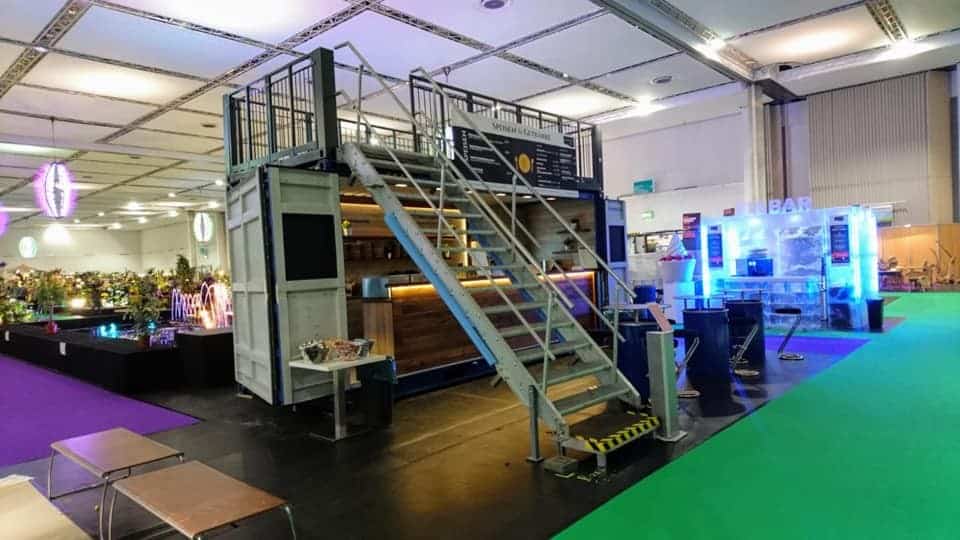
What happens to discarded sea containers? Sometimes, they are used as storage space by moving companies in their yard, or some resourceful architects even assemble them like a Lego house and convert them into family homes. But most of the metal giants are scrapped. The start-up Mein Lagerraum³ from Dresden has found another way to repurpose these containers. It transforms them into storage and cold-storage rooms, mobile workshops, construction site units, cocktail bars, stages, mobile laboratories, horse boxes and so on.
Patrick Schmieder, founder and managing director of Mein Lagerraum³, in an interview with Innovation Origins:

How did you come up with the idea for founding Mein Lagerraum³?
My cousin, Ramon’s brother, has a carpenter’s workshop and, in 2014, he needed storage space for material and tools. Together, we went through three different options and came up with sea containers as a suitable solution. Soon said and done, a container was procured. Other local tradespeople took note of this and were now also interested. From this, we developed a business idea: trading with sea containers in the hinterland.
What makes Mein Lagerraum³ special compared to other companies?
We live for the idea of expanding further and see ourselves as the conductor of an orchestra of service providers (construction, industrial design, metal construction, various other trades, freight forward/logistics) for the benefit of the customer. That’s how we make use of the appropriate service provider for the respective customer project. That makes us flexible and serves the customer comprehensively. In addition, we always offer a “turnkey solution” so that the customer can use us as a general contractor and hidden costs are minimised. We stand for: Containers, comprehensive solutions.
How do you decide where the containers will be placed? On request?
It depends on the customer’s wishes. A container is rather ‘idiotproof’. Four corner foundations or a solid base are required – nothing more. As long as the truck or truck-mounted crane is able to guarantee parking, (almost) anything is possible.
What was the biggest hurdle you had to overcome?
We were not given any start-up grants or extensive funding. We simply filled in a trade license, founded the GmbH and got started. Liquid funds are still our biggest hurdle. No matter whether it’s credit, loans or promotions. Currently, there is no financial injection, because the next major steps cannot be taken quickly during day-to-day business.
Was there a moment when you wanted to give up?
Yes, unfortunately, when one of our biggest customers suddenly filed for insolvency when we still had a five-figure sum overdue. And at that time, we had no insurance against those kind of losses.
And vice versa: What was the best moment for you with regard to the founding of Mein Lagerraum³, what made you particularly proud?

On one hand, that after just under three years, we are recognized as a brand and a serious competitor, and on the other, that we took 2nd place in May at the SACHSEN GRÜNDET – START-UP 2019.
What can we look forward to in the coming years, in other words: What can we expect from you in the coming years?
That straight-out trading and the leasing of “empty sea containers” will develop into normal day-to-day business. The focus will increasingly be on our expertise in special construction. Here, we will manufacture further event containers, expand the product range for the e-mobility sector and generally push industrial projects (we were allowed to manufacture explosion-protected containers, provide refrigerated container solutions for automotive suppliers, install computer centers + combined heat and power plants + hydrogen production + photovoltaic recycling plants in containers, etc.).
What is your vision for Mein Lagerraum³?
We would like to be an employer for many employees who are keen to come into work on Mondays and tell everyone about our passion. All in all, I would like to create a company according to the values of the book; “The Big Five for Life.”
Background:
Founder: Patrick Schmieder brings with him his know-how from his sales and marketing background. Ramon Schmieder provides support with strategy and technical understanding from the sidelines.
Year of foundation: 2015
Financing: Unfortunately, too much from private loans, a KfW loan, and day-to-day business.
Number of employees: Currently four.
On the same topic:
E-Mobility container for charging e-bikes and e-scooters
Are you interested in start-ups? An overview of all our articles on this topic can be found here.

